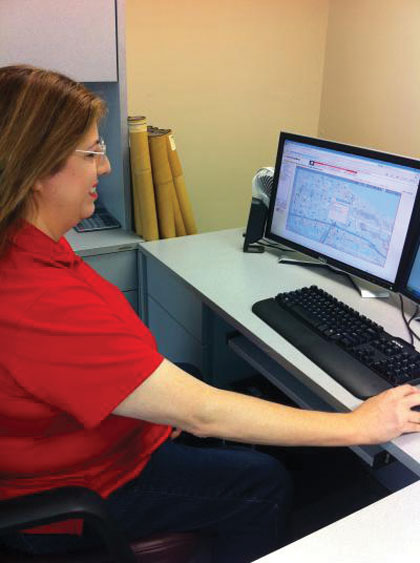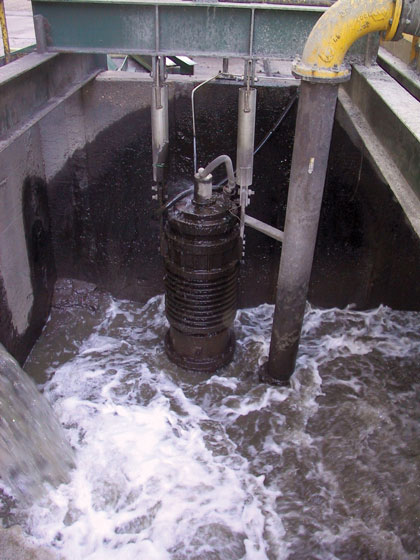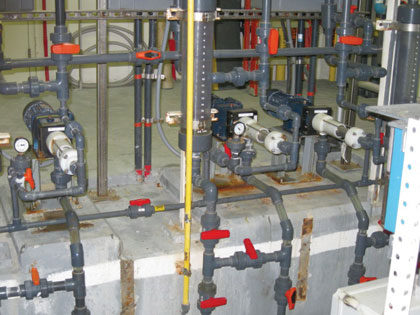An overflow in your guest bathroom might be little more than an inconvenience, but a sanitary sewer overflow (SSO) or combined sewer overflow (CSO) can present serious problems for a wastewater treatment facility. SSOs and CSOs can be caused by excessive stormwater rushing into the system, breakdowns at pump stations, or ruptures along the line. Of course, these causes are often difficult and sometimes impossible to predict. However, another cause of massive overflow that can be more precisely monitored and potentially eliminated are mishaps from operational failures, either through lack of information or misinterpretation of the data available.
If facility operators had better information available about their wastewater system, then one cause of SSOs and CSOs could be eliminated. Also, “better” information does not necessarily mean “more” information. In many cases, operators would greatly benefit merely from accessing the available information in a more user-friendly form or at a quicker pace. The cellular-based supervisory control and data acquisition (SCADA) system developed by Mission Communications, in conjunction with CMOM deployment, aims to do just that.

CMOM DEFINED
The capacity, management, operations, and maintenance (CMOM) program was established by the Environmental Protection Agency (EPA) to reduce regulatory non-compliance in wastewater collection and treatment systems. The goal of the CMOM program is to assure that effluent from treatment facilities is free from pollutants. Treatment plant operators use the CMOM program to demonstrate compliance with federal and state regulations that govern the water treatment industry. The framework of the CMOM program allows for periodic reviews of a collection system by the EPA and state inspectors. System reviews typically follow an established framework. That framework is a template for examining records, conducting field inspections and interviewing personnel. The purpose of CMOM programs include
- Helping utilities and municipalities ensure an adequate wastewater collection and treatment capacity;
- Assisting utilities and municipalities with better management, operations and maintenance of collection systems;
- Assisting operators with effective investigation of capacity-constrained areas within the collection system;
- Implementing programs or systems designed to proactively prevent SSOs and CSOs;
- Establishing procedures to help operators effectively respond to SSO/CSO events.
CMOM programs are primarily used for stormwater, treated wastewater and untreated wastewater discharges. CMOM programs are not mandatory. They are highly recommended tools used to assure that a facility is complying with EPA directives under federal laws. These laws include
- The Federal Water Pollution Control Amendments of 1972, more commonly known as the Clean Water Act (CWA), which is the principal law governing the release of water into all U.S. waterways;
- The Clean Water Act of 1977, which expanded the 1972 CWA to include wastewater operations;
- The Water Quality Act of 1987, which expanded the National Pollution Discharge Elimination System regulations created by the 1972 CWA to cover stormwater discharges and clarified standards for effluent treatment.
A properly executed CMOM program helps to reduce the potential for spills and violations. It also gives operators adequate warning to address minor problems before they become major problems. The timely receipt of alarms and notifications from a typical SCADA system drastically reduces the potential for pump station failure because it delivers timely alarms and notifications. That significantly reduces the potential for SSOs/CSOs, threats to public health and resulting property damage.

SCADA SYSTEMS TRACK PUMP EFFICIENCIES
Many EPA goals inherent in the CMOM program can be satisfied easily and inexpensively by the procurement and installation of cellular to web-based remote terminal units (RTUs). RTUs are reliable and can be installed quickly in any collection system. Their real-time notifications give personnel the ability to respond quickly to potentially hazardous events. They assist in developing streamlined preventive plans of action so utilities can comply with EPA mandates.
Well-designed wastewater collection and treatment systems should minimize the risk of service interruptions by monitoring the operation of critical pumps and equipment. That way repairs can be anticipated with timely, accurate and reliable information. In addition to providing real-time notifications, SCADA systems can track the efficiency of pumps and other equipment. Trending information like pump starts/stops and pump runtimes is used to prevent pump damage. Notifications are sent when pump anomalies occur and give personnel ample time to tend to the pump station before the pump becomes irreparable. An SSO/CSO scenario can be avoided when the operator can monitor pump efficiency and make repairs before an SSO/CSO incident occurs. The implementation of a SCADA system also demonstrates to regulators that best practices are being followed.

A properly executed CMOM program helps to reduce the potential for spills and violations. It also gives operators adequate warning to address minor problems before they become major problems.
CAPACITY ESTIMATOR TOOL IS AN ASSET FOR CMOM PROGRAMS
Kris Riemann is the director of engineering for the city of Gulfport, Mississippi. He is responsible for the planning, budgeting and execution of all capital projects, including water and sewer projects. The Gulfport system is heavily reliant on the Mission Communications SCADA systems to remain well-informed of all system functions at remote locations which include collections and distribution. Riemann worked closely with Mission engineers to develop the Capacity Estimator tool,which is a standard part of the Web-based software.
“We use the Capacity Estimator to help us determine if capacity is keeping up with development and inflow/infiltration (I and I) within each branch of our collection system,” Reimann explains. “This helps us prevent overflows and over-taxing system capacity. We follow CMOM recommendations to show compliance with CMOM standards. The EPA recommends that all systems install SCADA. Our installation of the Mission equipment demonstrates that we follow those guidelines. The Mission website tools and the data collected by the equipment helps us to stay in compliance and it allows us to make better management decisions.”

An SSO/CSO scenario can be avoided when the operator can monitor pump efficiency and make repairs before an SSO/CSO incident occurs.
MEASURING EFFICIENCY WITH A CMOM PROGRAM
Joanne Massony, Kenner, Louisiana wastewater director for Veolia Water, first installed a SCADA system in 2007. “When we installed the SCADA units, we found that several pumps ran too long because we had I and I issues,” Massony says. “This led to serious maintenance issues. When we had heavy rain, we discovered that some pumps ran all day. The Mission system helped us to identify the pumps that were not running efficiently. That led to a streamlined and targeted maintenance plan.”
A properly designed data collection system gives the operator the ability to provide governing boards and councils evidence of shortcomings and successes. Like many other collections systems in the nation, the Kenner system was battling the cumulative effects of I and I each year. Increasing I and I maximized system capacity and put Kenner in jeopardy of potential violations.
Kenner officials realized they would not be able to effectively manage the capacity aspect of their CMOM program until they solved their I and I issues. They began by collecting and analyzing data to determine the extent of the I and I problems. Reports provided by Mission Communications gave Kenner the ability to measure peak flows. The city then used the data to design and implement a plan to identify and repair problem areas. The Mission SCADA system streamlined and simplified recordkeeping. Operators were able to utilize the trending data to compare flows over month-to-month or year-to-year periods and track the impact of growth within the system. This data allowed them to stay within CMOM guidelines, identify improvements and make plans for emergency situations.
ELIMINATING ENVIRONMENTAL HAZARDS WITH A CMOM PROGRAM
David Kellogg is the assistant superintendent of public utilities for the city of Gallatin, Tennessee, Department of Public Utilities. His responsibilities include the oversight of pump station maintenance for Gallatin utility system collections. Gallatin installed the managed SCADA solution offered by Mission Communications in 2006. Kellogg has found the system to be extremely helpful in operating the utility safely and reducing the potential for reported spills.
“We receive an alarm from the SCADA system if we have a really heavy rainfall or a pump outage,” Kellogg explains. “We can bring in portable pumps to get the effluent into the outflow pipe, and avoid a potential spill situation.”
The Mission system includes an automatic report function that measures pump runtime variance. This report keeps track of all runtimes for each pump over the current thirty-day time frame. Any runtime that exceeds the predetermined statistical variance for the past thirty days is flagged and Kellogg receives an email notification from his Web-based system.
“The pump runtime variance report alone has helped us prevent numerous potential spills. If any pump runs a lot longer or shorter than it normally does, that’s something I want to know about,” adds Kellogg.
Measuring runtime variance is a tool that can help personnel quickly identify stations in which pumps are working at an optimal level. The identified stations become obvious targets for immediate routine maintenance. Accurate runtime information can prevent many problems before they occur when the data is properly interpreted.
EXCEPTIONAL VALUE FOR A BETTER TOMORROW
A cellular-based SCADA system is a valuable way for utilities to initialize a CMOM program. Every wastewater utility can benefit from the design and implementation of a CMOM program. Utilities can meet their goals of efficiently serving the public when they identify effective ways of executing CMOM program recommendations. Properly applied CMOM guidelines typically save most utilities a significant amount of time and money previously lost to system inefficiencies. ■
_________________________________________________________________________
ABOUT THE AUTHOR
Lauryn Colquitt is the marketing coordinator for Mission Communications. To learn more on how Mission makes SCADA simple, visit www.123mc.com.
_________________________________________________________________________
MODERN PUMPING TODAY, March 2013
Did you enjoy this article?
Subscribe to the FREE Digital Edition of Modern Pumping Today Magazine!
![]()


